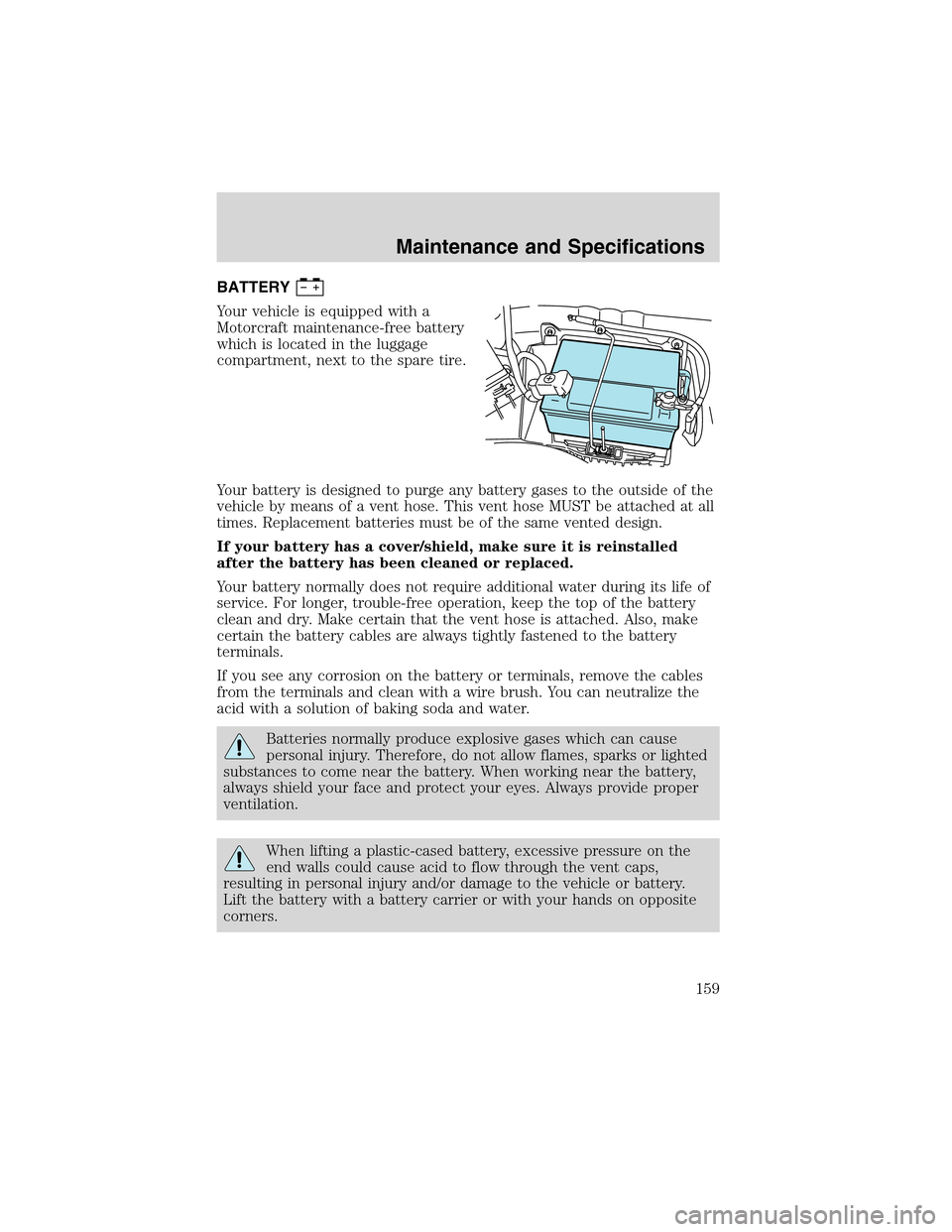Page 136 of 200
Removing the jumper cables
Remove the jumper cables in the reverse order that they were
connected.
1. Remove the jumper cable from the spare tire tie-down stud.
2. Remove the jumper cable on the negative (-) connection of the
booster vehicle’s battery.
+–+–
+–+–
Roadside Emergencies
136
Page 159 of 200

BATTERY
Your vehicle is equipped with a
Motorcraft maintenance-free battery
which is located in the luggage
compartment, next to the spare tire.
Your battery is designed to purge any battery gases to the outside of the
vehicle by means of a vent hose. This vent hose MUST be attached at all
times. Replacement batteries must be of the same vented design.
If your battery has a cover/shield, make sure it is reinstalled
after the battery has been cleaned or replaced.
Your battery normally does not require additional water during its life of
service. For longer, trouble-free operation, keep the top of the battery
clean and dry. Make certain that the vent hose is attached. Also, make
certain the battery cables are always tightly fastened to the battery
terminals.
If you see any corrosion on the battery or terminals, remove the cables
from the terminals and clean with a wire brush. You can neutralize the
acid with a solution of baking soda and water.
Batteries normally produce explosive gases which can cause
personal injury. Therefore, do not allow flames, sparks or lighted
substances to come near the battery. When working near the battery,
always shield your face and protect your eyes. Always provide proper
ventilation.
When lifting a plastic-cased battery, excessive pressure on the
end walls could cause acid to flow through the vent caps,
resulting in personal injury and/or damage to the vehicle or battery.
Lift the battery with a battery carrier or with your hands on opposite
corners.
Maintenance and Specifications
159
Page 179 of 200

5.Installanew air filter element. Be careful not to crimp the filter
element edges between the air filter housing and cover. This could cause
filter damage and allow unmetered air to enter the engine if not properly
seated.
6. Replace the air filter housing cover and secure the clamps.
INFORMATION ABOUT UNIFORM TIRE QUALITY GRADING
New vehicles are fitted with tires
that have a rating on them called
Tire Quality Grades. The Quality
grades can be found where
applicable on the tire sidewall
between tread shoulder and
maximum section width. For
example:
•Treadwear 200 Traction AA Temperature A
These Tire Quality Grades are determined by standards that the United
States Department of Transportation has set.
Tire Quality Grades apply to new pneumatic tires for use on passenger
cars. They do not apply to deep tread, winter-type snow tires,
space-saver or temporary use spare tires, tires with nominal rim
diameters of 10 to 12 inches or limited production tires as defined in
Title 49 Code of Federal Regulations Part 575.104(c)(2).
U.S. Department of Transportation-Tire quality grades:The U.S.
Department of Transportation requires Ford to give you the following
information about tire grades exactly as the government has written it.
Treadwear
The treadwear grade is a comparative rating based on the wear rate of
the tire when tested under controlled conditions on a specified
government test course. For example, a tire graded 150 would wear one
and one-half (1 1/2) times as well on the government course as a tire
graded 100. The relative performance of tires depends upon the actual
conditions of their use, however, and may depart significantly from the
norm due to variations in driving habits, service practices, and
differences in road characteristics and climate.
Maintenance and Specifications
179
Page 195 of 200

Safety belts
(see Safety restraints) .........70–73
Safety defects, reporting ..........147
Safety restraints ....................70–74
belt minder ...............................75
extension assembly ..................79
for adults .............................71–73
for children ...............................91
safety belt maintenance ...........79
warning light and chime ....74–75
Safety seats for children ............94
Seat belts
(see Safety restraints) ...............70
Seats ............................................66
child safety seats ......................94
cleaning ...................................151
Select Shift Transmission
(SST) shifter .............................111
Servicing your vehicle ..............154
Spare tire (see Changing
the Tire) ....................................127
Spark plugs,
specifications .....................182, 186
Specification chart,
lubricants ...........................184, 186
Speed control ..............................39
Starting your vehicle ........102–104
jump starting ..........................132
Steering
speed sensitive .......................108
Steering wheel
controls ......................................42
tilting .........................................36T
Tires ...........................127, 179–180
changing ..........................127–128
checking the pressure ............180
replacing ..................................181
rotating ....................................181
snow tires and chains ............182
tire grades ...............................180
treadwear ................................179
Towing .......................................115
recreational towing .................115
trailer towing ..........................115
wrecker ....................................138
Traction control ........................106
Transmission .............................108
fluid, checking and adding
(automatic) .............................177
fluid, refill capacities ..............183
lubricant specifications ..184, 186
Trunk ...........................................56
remote release ....................39, 58
Turn signal ..................................27
V
Vehicle dimensions ...................186
Vehicle Identification Number
(VIN) ..........................................188
Vehicle loading ..........................114
Ventilating your vehicle ...........105
Index
195